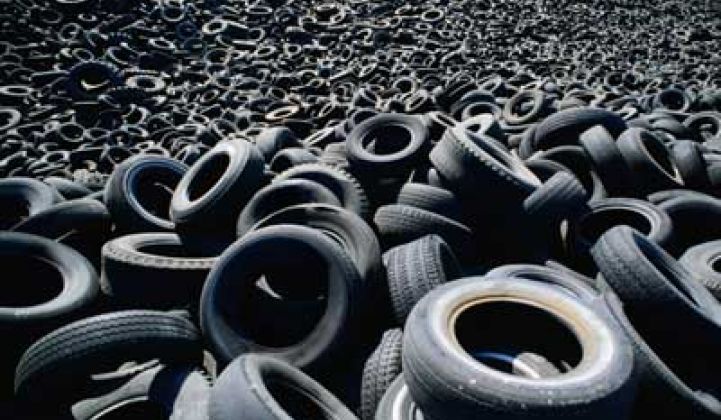There’s only so much you can do with used tires. Most of the 300 million or so thrown away every year in the United States are shredded and converted to fuel for cement plants, paper mills, industrial boilers and the like. If they’re lucky, they may find a future home as asphalt or in “ground rubber” applications, like giving the bounce in an Astroturf field.
Lehigh Technologies says it has come up with a new method that can turn the same tire scraps into a micronized rubber powder (MRP) product, one that can replace expensive resins and other polymers for a host of products. Its factory near Atlanta, Ga. is capable of churning out about 100 million pounds of MRP per year, CEO Alan Barton said.
About half that capacity is now being engaged by customers right now, he said. They’re buying MRP to make building coatings and insulation, industrial plastics, asphalt, and yes, new tires, as customer The Yokohama Rubber Co. has been doing for about four years now.
“We’ve got plenty of room to grow, which is a good thing, because our growth rates have been greater than 30 percent, year over year,” Barton said in a Wednesday interview.
To support that business growth, Lehigh has been raising a new round of capital in the range of $16 million to $17 million, Barton said. So far it has raised “way over half” its target, he said, most recently with a $5 million round from Washington, D.C.-based Leaf Clean Energy. (An article from the Atlanta Business Journal put the current raise at $13 million so far of a planned $19 million round.)
Founded in 2003, the Tucker, Ga.-based company raised an undisclosed amount from angel investors and bought a German company called Micro-Tec, which provided the "TurboMill" technology that went into its first plant that opened in 2006 at a cost of about $15 million, Barton said.
The company raised $18 million in a round let by NGP Energy Technology Partners in 2007, and a $34.5 million round in 2008 in a round that brought Kleiner Perkins Caufield & Byers and Index Ventures on board.
Shortly after that, the company underwent a management change that brought in Barton, who had previously served as an executive at chemical company Rohm and Hass.
“We hunkered down, cut our burn rate, and repositioned the company as almost a specialty materials provider,” Barton said of the shift that’s occurred since then. Beyond fine-tuning its MRP manufacturing process, Lehigh also put a lot of work into its application and development center, which works with customers to make sure the MRP it’s producing fits their specific needs, he said.
“We don’t claim any novel breakthrough here -- this is exactly how the specialty chemicals industry works,” he said. But whereas the building materials and plastics industries wouldn’t want anything to do with the rubber “crumb” product usually yielded from today’s tire-shredding processes, Lehigh is delivering a product that’s as fine as flour, and capable of replacing a host of resins and other raw materials, he said.
Lehigh takes an opposite tack from processes like pyrolysis, or superheating tires in an oxygen-free chamber. Instead, it freeze-dries tire scraps using liquid nitrogen, then runs that frozen rubber through a turbo mill, which Barton described as a “jet engine with teeth,” which shatters the slurry into tiny particles that are then separated into different levels of fineness.
Barton said that Lehigh can do so at costs about 50 percent cheaper than the raw materials they’re replacing. That’s both because of the comparatively low cost of its continuous process, and because of fact that used tires are something people get paid to dispose of, usually via state fees on new tire sales to fund recycling programs.
As for potential market growth, the Rubber Manufacturers Association trade group reports that the U.S. generated about 4.4 million tons of scrap tire material in 2009, up from 3.6 million tons in 2005. Right now, Lehigh’s plant is capable of processing about 100 million pounds of MRP, or 50,000 tons, per year -- or about 1/88th of the total weight of scrap tires otherwise burned for fuel or shredded into landscape and civil engineering filler each year.
Converting even a tiny fraction more of that product into useful precursors for plastics and other polymers could turn tires from a recycler’s nightmare material to something actually valuable to the market. Maybe there’s gold in those used tires after all.



